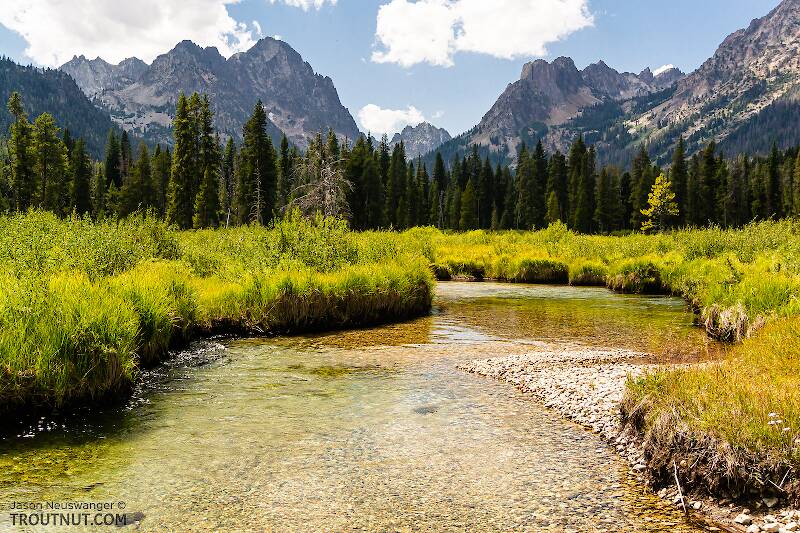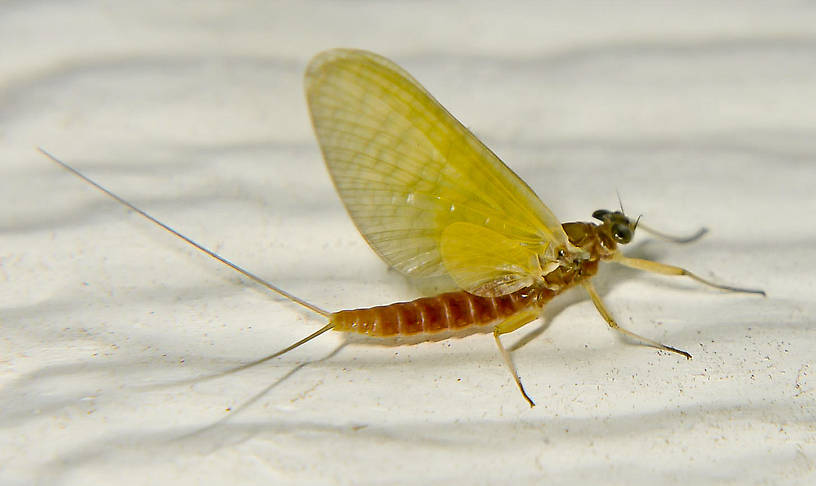
Salmonflies
Pteronarcys californica
The giant Salmonflies of the Western mountains are legendary for their proclivity to elicit consistent dry-fly action and ferocious strikes.
Featured on the forum

I was not fishing, but happened to be at an unrelated social event on a hill above this tiny creek (which I never even saw) when this stonefly flew by me. I assume it came from there. Some key characteristics are tricky to follow, but process of elimination ultimately led me to Sweltsa borealis. It is reassuringly similar to this specimen posted by Bob Newell years ago. It is also so strikingly similar to this nymph from the same river system that I'm comfortable identifying that nymph from this adult. I was especially pleased with the closeup photo of four mites parasitizing this one.

Troutnut is a project started in 2003 by salmonid ecologist Jason "Troutnut" Neuswanger to help anglers and
fly tyers unabashedly embrace the entomological side of the sport. Learn more about Troutnut or
support the project for an enhanced experience here.
Dark Rusty Spinners
Like most common names,"Dark Rusty Spinner" can refer to more than one taxon. They're previewed below, along with 5 specimens. For more detail click through to the scientific names.
Mayfly Species Hexagenia atrocaudata
These are very rarely called Dark Rusty Spinners.
This species is slightly smaller than Hexagenia limbata and it occurs later in the year. It is only mentioned in passing by a few authors, but it can be locally important.
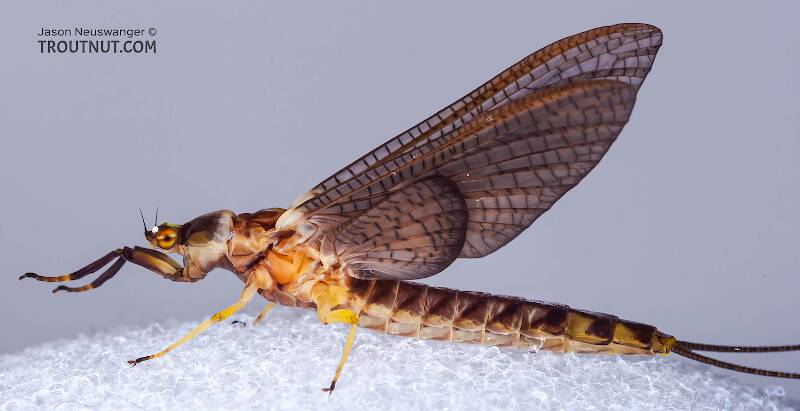
I found this lone Hexagenia atrocaudata dun fluttering by herself on the surface of a small, still stretch of river one evening as I paddled home from fishing for smallmouths in the warm August weather.
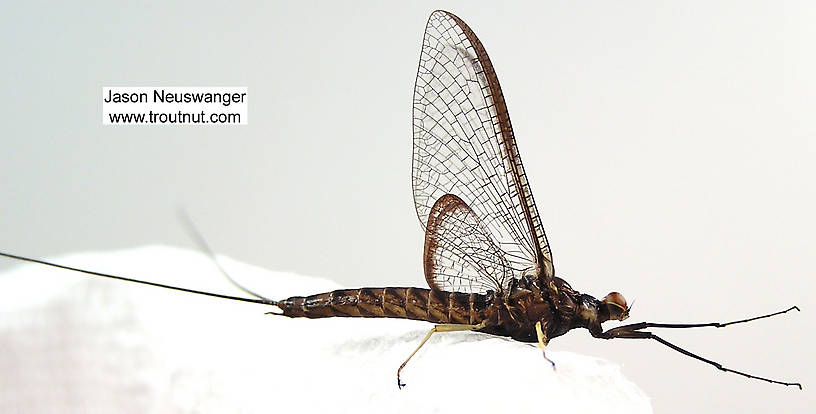
I found this spinner and a few of his friends bobbing above the river amidst a snowstorm hatch of white Ephoron flies.
See 1 more specimen...
Mayfly Species Cinygmula reticulata
These are very rarely called Dark Rusty Spinners.
Cinygmula reticulata is probably the second most important species of Cinygmula behind Cinygmula ramaleyi, perhaps because the waters where it can be found in good numbers are often more remote. They have been reported as abundant in many high country streams of the Southern Rockies as well as the High Sierra's Eastern slope. An obvious difference in their coloration may be the easiest way to tell them apart. Cinygmula ramaleyi is more somber with a brownish body and dark gray wings and is often confused with the similar sized and colored Ephemerella tibialis, in spite of the difference in tail counts. Cinygmula reticulata on the other hand is a bright cinnamon dorsally with pale creamy legs and pale wings that are often a brilliant canary yellow. This is one of North America's most beautiful mayflies.
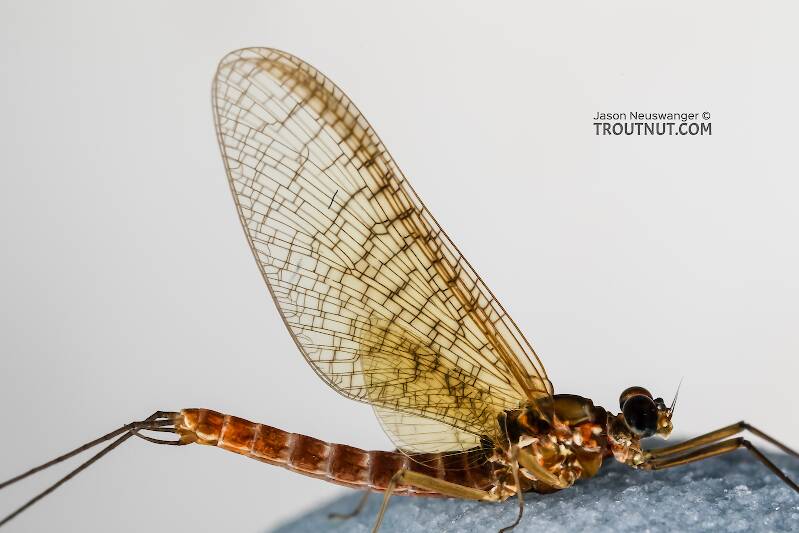
The lengths of the wing and body, measured with a caliper, are both 8 mm.
Keys in Needham's 1935 Biology of Mayflies point to either Cinygmula reticulata or Cinygmula gartrelli. It seems to have crossveins in costal half of forewing only, slightly margined with brown and wings tinged with amber at base and along costal margin of both wing (gartrelli) as opposed to all crossveins of both wings faintly but broadly margined with pale smoky and wings entirely amber-tinged (although there is a slight amber tinge throughout, just more pronounced in places) as in reticulata. However, wing length reported for reticulata (9 mm) is closer to this specimen than gartrelli (10 mm). Ventral median marks are supposed to be "traces" for reticulata and "present" for gartrelli. Descriptions for both species involve semi-hyaline anterior abdominal segments not present on my specimens. Distribution records suggest reticulata lives nearby, so I'm going with that, but I can't confidently rule out gartrelli.
Keys in Needham's 1935 Biology of Mayflies point to either Cinygmula reticulata or Cinygmula gartrelli. It seems to have crossveins in costal half of forewing only, slightly margined with brown and wings tinged with amber at base and along costal margin of both wing (gartrelli) as opposed to all crossveins of both wings faintly but broadly margined with pale smoky and wings entirely amber-tinged (although there is a slight amber tinge throughout, just more pronounced in places) as in reticulata. However, wing length reported for reticulata (9 mm) is closer to this specimen than gartrelli (10 mm). Ventral median marks are supposed to be "traces" for reticulata and "present" for gartrelli. Descriptions for both species involve semi-hyaline anterior abdominal segments not present on my specimens. Distribution records suggest reticulata lives nearby, so I'm going with that, but I can't confidently rule out gartrelli.
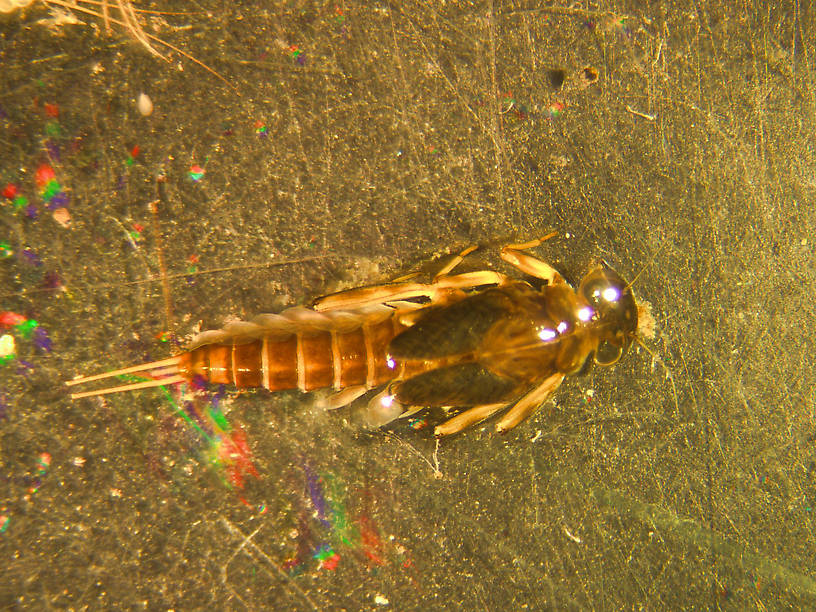
I collected several live specimens of nymphs and reared them to the imago stage. They were C. reticulata. The interesting thing is they were collected in May and were emerging along with Rhithrogena (March Brown). This seems to be an overlooked hatch since in some rivers it emerges very early, before runoff.

